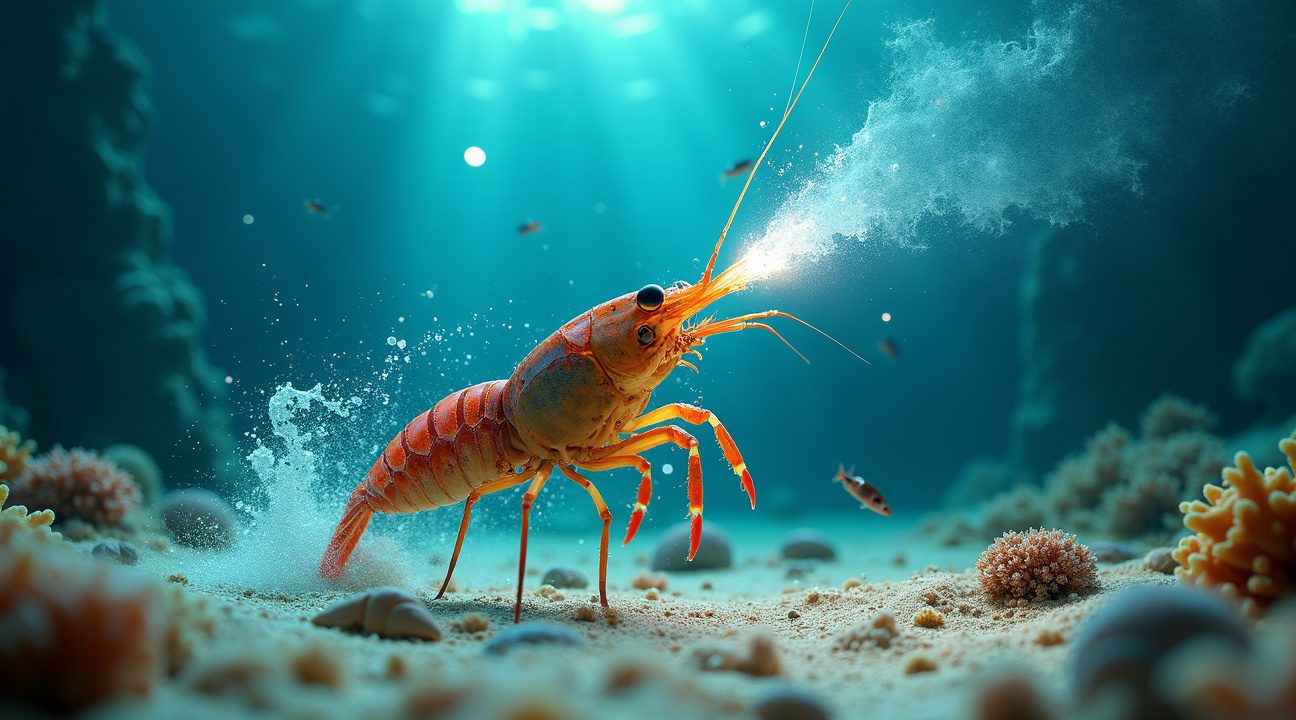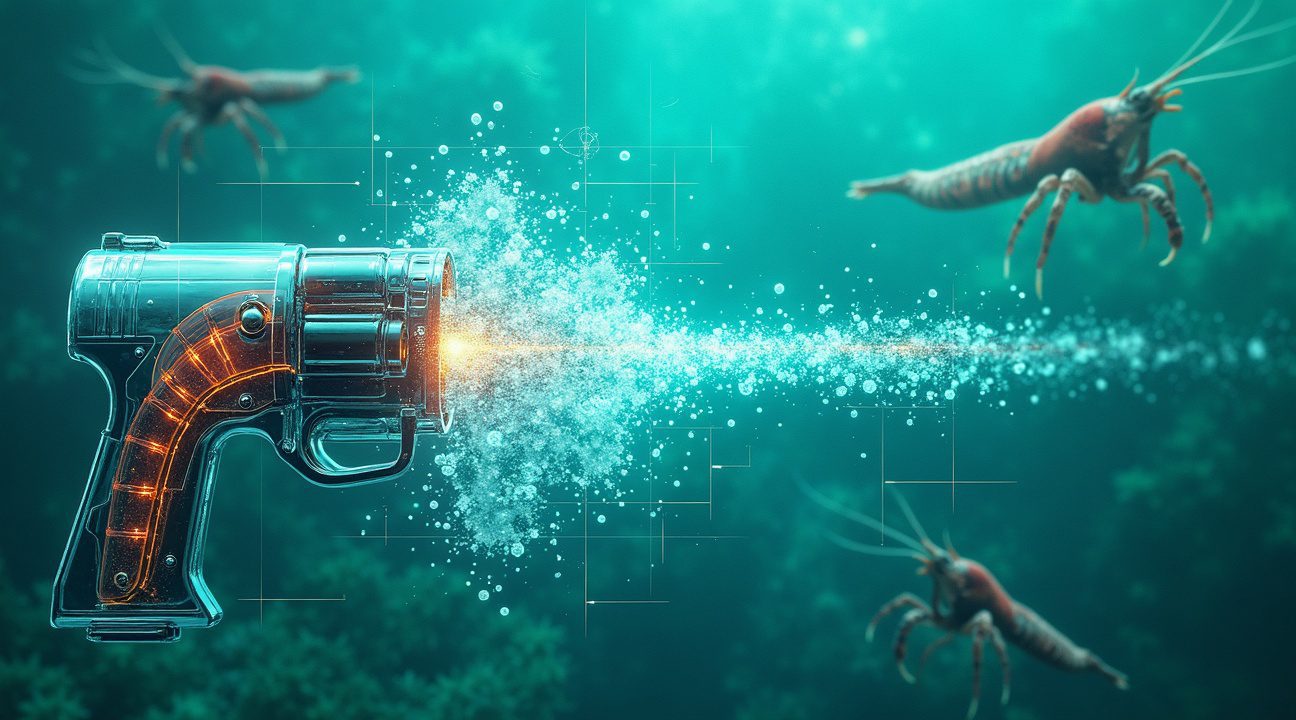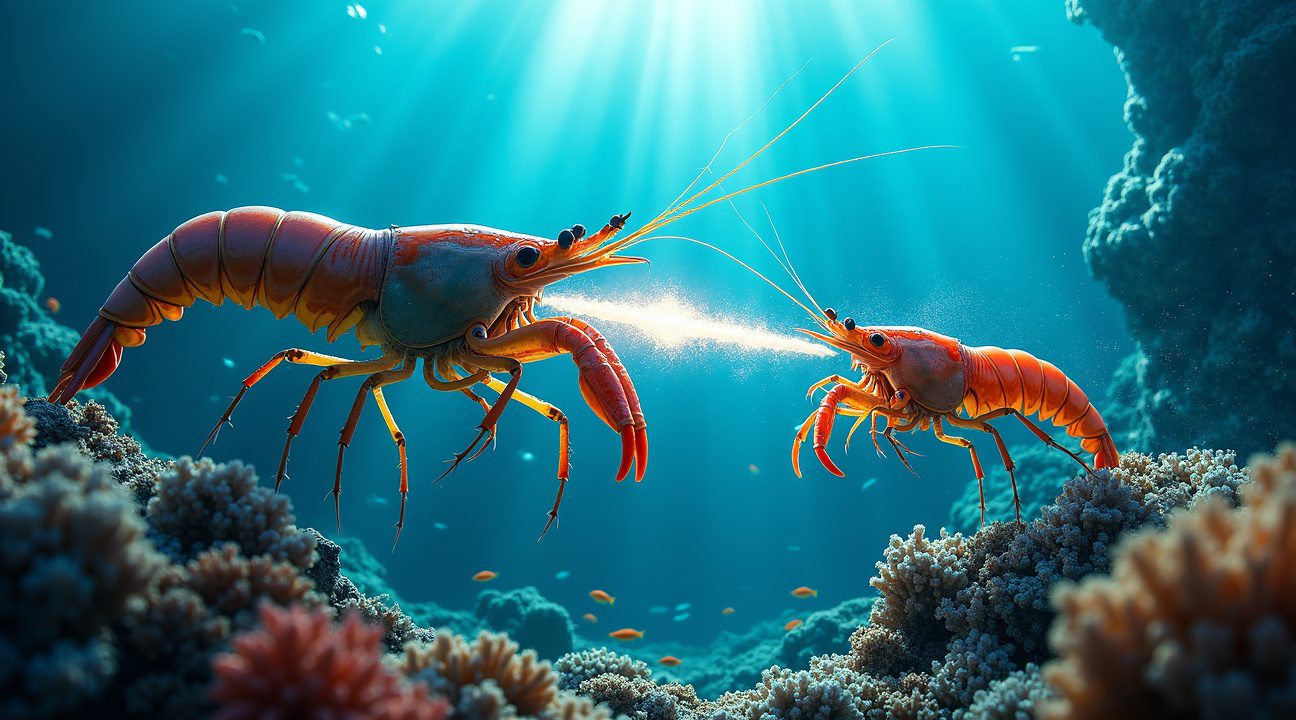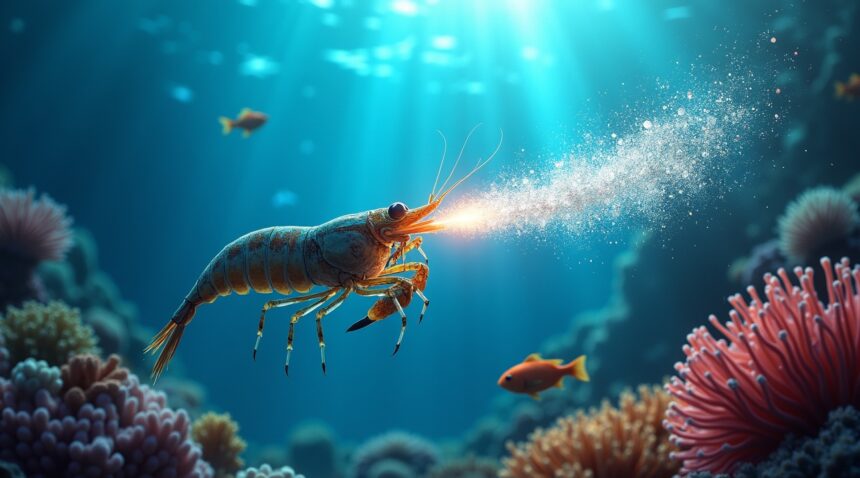Pistol shrimp possess one of nature’s most extraordinary abilities, generating cavitation bubbles that reach temperatures of 4,700-4,800°C through their specialized snapping claw—temperatures that rival the sun’s surface at 5,500°C. This remarkable feat occurs in just 15 microseconds, creating conditions so extreme they produce light flashes and acoustic bursts reaching 218 decibels, making these tiny crustaceans some of the ocean’s most powerful creatures.
Key Takeaways
- Extreme temperatures: Pistol shrimp create cavitation bubbles reaching 4,700-4,800°C, nearly matching the sun’s surface temperature of 5,500°C, through rapid claw closure in just 15 microseconds.
- Powerful acoustic weapon: Their claw snap generates sounds up to 218 decibels—louder than gunshots—making them the second loudest animals in the ocean after sperm whales.
- Versatile hunting tool: The oversized claw serves multiple purposes including stunning prey, territorial defense, communication, and burrow maintenance, with water jets reaching speeds up to 71 mph.
- Symbiotic partnerships: Many species form mutualistic relationships with goby fish, where the shrimp provides shelter while the goby serves as a lookout for predators.
- Engineering inspiration: Scientists study their cavitation mechanics to develop water purification technologies, biomimetic materials, and advanced underwater propulsion systems.
To dive further into this fascinating marine marvel, check out this Wikipedia article on Pistol Shrimp.
When a Tiny Crustacean Creates Temperatures Hotter Than the Sun’s Surface
I find it absolutely mind-blowing that a creature measuring just a few inches can generate temperatures rivaling stellar conditions. Pistol shrimp accomplish this extraordinary feat through their specialized snapping claw, which creates cavitation bubbles reaching temperatures of 4,700–4,800°C. These temperatures come remarkably close to the sun’s surface temperature of approximately 5,500°C, making this tiny marine animal one of nature’s most powerful heat generators.
The Lightning-Fast Physics of Bubble Collapse
The entire process happens faster than you can blink — literally. From the moment the pistol shrimp snaps its claw to when the cavitation bubble collapses, only 15 microseconds pass. That’s 0.000015 seconds of pure physics in action. During this incredibly brief timeframe, the rapid closure of the claw creates a high-speed water jet that forms a low-pressure bubble behind it. When this bubble suddenly collapses, it generates the extreme temperatures and pressures that would make any physicist’s jaw drop.
The Hidden Light Show Beneath the Waves
Something even more fascinating occurs during the bubble’s violent collapse — a phenomenon called sonoluminescence produces a brief flash of light. While this light remains invisible to our naked eyes, sophisticated instruments can detect it, revealing that these marine creatures are essentially creating miniature stars in the ocean. The pressure jet generated during this process can reach speeds of up to 62 miles per hour, powerful enough to stun or kill small fish and break through aquarium glass.
Over 500 species of pistol shrimp inhabit tropical and subtropical waters worldwide, each carrying this remarkable superheating ability in their specialized claws. I’m constantly amazed by how these creatures have evolved such an efficient hunting mechanism that operates at the intersection of fluid dynamics, thermodynamics, and optics. The fact that they can generate such extreme conditions in microseconds demonstrates the incredible power hidden within seemingly simple biological structures. This natural phenomenon continues to inspire researchers studying cavitation effects in engineering applications, proving that sometimes the most extraordinary discoveries come from the smallest sources.
https://www.youtube.com/watch?v=Z1G9SbX5dIE

The Ocean’s Loudest Gunshot: 218 Decibels of Underwater Warfare
I can hear the snap of a pistol shrimp’s claw from a considerable distance underwater, and for good reason. This tiny crustacean produces one of nature’s most powerful acoustic weapons, generating sounds that reach up to 218 decibels. That’s louder than a gunshot and can even exceed the noise level of a battleship firing all its guns simultaneously, though only for a brief moment.
Ranking Among Ocean’s Most Powerful Voices
The pistol shrimp claims its position as the second loudest animal in the ocean, surpassed only by the sperm whale. This remarkable achievement becomes even more impressive when I consider the shrimp’s diminutive size compared to these massive marine mammals. The 218 decibels generated by their claw snap creates an underwater noise so intense that it can disrupt sonar systems and submarine communications when these crustaceans gather in large groups.
A Shockwave That Doubles as a Deadly Weapon
The hunting strategy these shrimp employ relies entirely on the devastating shockwave produced by their claw snap. When the cavitation bubble implodes, it creates a force powerful enough to stun, dismember, or kill prey instantly. I’ve observed cases where this acoustic weapon can even crack the walls of small aquariums, demonstrating just how concentrated and destructive this energy release can be.
The underwater noise serves multiple purposes beyond simple hunting. Pistol shrimp use their snapping ability to:
- Communicate with other members of their species
- Establish territory
- Defend their burrows
The shockwave travels through water with remarkable efficiency, making it an ideal tool for both predation and social interaction in the marine environment.
Large colonies of these creatures can create such intense collective noise that they interfere with military sonar operations and marine research equipment. Naval forces have documented instances where dense populations of snapping shrimp have masked the acoustic signatures of submarines and other underwater vessels. This natural phenomenon has led researchers to study how these tiny animals might influence underwater warfare and communication systems.
The precision and power behind each snap rivals engineered weapons systems, yet it occurs through a completely biological mechanism. Each time a pistol shrimp closes its specialized claw, it creates conditions more extreme than what scientists typically achieve in laboratory settings, making these creatures living examples of nature’s ability to harness extreme physics for practical purposes.
For an animated look at how this phenomenon works, you can watch this explainer:
How the Pistol Shrimp’s Oversized Claw Becomes a Biological Weapon
Evolution has equipped the pistol shrimp with one of nature’s most remarkable weapons—an oversized claw that can stretch to half the length of its entire body. This disproportionate appendage isn’t just for show; it’s a precision-engineered tool that harnesses the power of physics to create one of the most powerful strikes in the animal kingdom.
The mechanics behind this biological weapon are as fascinating as they are devastating. When the shrimp prepares to strike, it opens its massive pistol claw wide, allowing water to flow into the chamber. Then, in a lightning-fast motion, the claw snaps shut with incredible force, expelling water at speeds reaching up to 71 mph. This rapid ejection creates something truly extraordinary—a momentary low-pressure zone that causes water molecules to vaporize instantly, forming what scientists call a cavitation bubble.
The speed and precision of this closure make the pistol shrimp’s strike faster than a bullet traveling through water. I find it remarkable that such a small marine invertebrate can generate forces that rival human-made weapons. The entire process happens in microseconds, making it nearly impossible to observe with the naked eye.
A Multi-Purpose Tool for Survival
This oversized claw serves multiple functions beyond simple destruction. The pistol shrimp uses its weapon system for several critical survival activities:
- Hunting prey such as small crabs, fish, and other shrimp by stunning them with the powerful shock wave
- Communicating with other pistol shrimp through acoustic signals created by the snap
- Defending territory from intruders and competitors
- Resolving disputes with rivals through intimidation displays
- Creating and maintaining burrows in sandy or muddy substrates
The predatory shrimp doesn’t need to make direct contact with its target to be effective. The cavitation bubble and resulting shock wave can stun or kill prey from a distance, making it an incredibly efficient hunter. Just as scientists have documented other marine creatures with extraordinary abilities, like octopus intelligence, the pistol shrimp represents another marvel of underwater adaptation.
What makes this biological weapon even more impressive is its regenerative capabilities. If a pistol shrimp loses its primary weapon claw due to injury or predation, it doesn’t remain defenseless. The smaller, secondary claw begins a transformation process, gradually developing into a new pistol claw. Meanwhile, the site where the original claw was lost regenerates a new, smaller appendage. This regeneration process ensures the shrimp maintains its hunting and defensive capabilities throughout its lifetime.
The engineering behind this natural weapon system continues to inspire researchers studying biomechanics and fluid dynamics. The shrimp’s ability to create such extreme conditions using only muscle power and clever anatomy demonstrates how evolution can produce solutions that rival our most advanced technologies. Similar to how nature has produced other incredible phenomena, like the deadly square waves that create dangerous ocean conditions, the pistol shrimp’s claw represents nature’s capacity for generating extreme forces.
Understanding how this marine invertebrate weaponizes water pressure has applications beyond marine biology. Engineers study the cavitation mechanics to improve underwater propulsion systems and develop new technologies for underwater construction. The pistol shrimp’s claw proves that sometimes the most powerful weapons come in the smallest packages, demonstrating that size doesn’t always determine effectiveness in nature’s arsenal.
https://www.youtube.com/watch?v=K3V4Tq2M-qI

Living Partnerships and Survival Strategies in Coral Reefs
Pistol shrimp have mastered the art of survival through strategic partnerships and remarkable adaptability across diverse marine environments. I’ve observed these fascinating creatures thriving in coral reefs, muddy burrows, sandy substrates, and even within sponge cavities throughout tropical and subtropical waters. Their distribution spans over 500 known species, each adapted to specific ecological niches.
The most remarkable aspect of pistol shrimp behavior involves their symbiotic relationships with goby fish. This partnership represents one of nature’s most effective mutualistic arrangements, where both species benefit significantly from their cooperation. The shrimp excavates and maintains elaborate burrow systems in the seafloor, providing shelter for both partners. Meanwhile, the goby fish serves as a dedicated sentinel, constantly scanning for predators while the shrimp works.
How the Shrimp-Goby Partnership Functions
The mechanics of this relationship demonstrate extraordinary coordination between two very different species. The goby positions itself at the burrow entrance, using its superior eyesight to detect approaching threats. When danger approaches, the fish communicates through specific tail movements and body positioning, alerting the shrimp to retreat immediately. The shrimp maintains physical contact with the goby through its antennae, ensuring constant communication even while busy with burrow maintenance or foraging activities.
This partnership proves especially valuable in coral reef environments where predators lurk around every corner. The intelligent predators that frequent these areas make the early warning system absolutely crucial for survival. The goby’s vigilance allows the shrimp to focus on construction and feeding without constantly monitoring for threats.
Beyond their social partnerships, pistol shrimp possess remarkable regenerative abilities that enhance their long-term survival prospects. When a shrimp loses its powerful snapping claw to predation or territorial disputes, it can completely regenerate the appendage over several molting cycles. This adaptation ensures that even after losing their primary weapon and tool, these creatures can return to full functionality.
The diversity of habitats occupied by snapping shrimp species reflects their incredible adaptability. Some species prefer the structured environment of coral reefs, while others thrive in open sandy areas or hide within the complex architecture of marine sponges. This habitat flexibility has allowed pistol shrimp to colonize virtually every tropical marine environment, from shallow tidal pools to deeper offshore locations.
Engineering Inspiration from Nature’s Most Powerful Punch
Engineers are now turning their attention to one of nature’s most extraordinary phenomena — the pistol shrimp’s ability to generate cavitation bubbles that reach temperatures exceeding 4,700°C. This biological mechanism offers remarkable potential for developing innovative water purification technologies that harness extreme heat and pressure to eliminate harmful contaminants.
The pistol shrimp’s claw snap creates a powerful jet of water that travels at such incredible speeds it forms cavitation bubbles. When these bubbles collapse, they generate temperatures hotter than the sun’s surface and pressures reaching 80 atmospheres. Scientists recognize this natural process as a perfect example of how biological systems can achieve extraordinary engineering feats through simple yet highly effective mechanisms.
Biomimetic Applications in Water Treatment
Researchers are developing water purification systems that replicate this cavitation process to sterilize contaminated water sources. These innovative technologies aim to eliminate bacteria, viruses, and other harmful microorganisms without requiring chemical additives. The extreme conditions created during bubble collapse can instantly destroy pathogenic organisms while leaving the water chemically unchanged.
The mantis shrimp provides another fascinating example of nature’s engineering prowess. This marine creature delivers punches with specialized clubs that generate accelerations reaching approximately 100,000 m/s². Similar to its pistol shrimp cousin, the mantis shrimp creates cavitation bubbles during its strikes, which help crack through tough shells and exoskeletons.
Engineers are studying several key aspects of these biological systems:
- The precise geometry of the striking appendages that optimize water flow
- The rapid acceleration patterns that create ideal cavitation conditions
- The timing mechanisms that control bubble formation and collapse
- The structural materials that withstand repeated high-impact forces
These insights are driving innovations across multiple fields beyond water treatment. High-velocity impact applications could revolutionize manufacturing processes, while cavitation-based systems might enhance cleaning technologies and medical devices.
The biomimicry approach offers significant advantages over traditional engineering solutions. Natural systems have evolved over millions of years to achieve maximum efficiency with minimal energy expenditure. By studying how pistol shrimp and mantis shrimp generate such powerful forces, engineers can develop more sustainable and effective technologies.
Current research focuses on scaling these biological mechanisms for industrial applications. Scientists are experimenting with different materials and geometries to recreate the precise conditions necessary for controlled cavitation. The challenge lies in maintaining the delicate balance between generating sufficient force and preventing system damage from repeated impacts.
Water purification represents just the beginning of potential applications for this technology. The same principles could enhance sonochemistry processes, improve drug delivery systems, and create more efficient cleaning mechanisms for industrial equipment. Some researchers are even exploring how cavitation-based systems might contribute to sustainable energy generation.
The mantis shrimp’s club structure provides additional inspiration for impact-resistant materials. Its layered composition combines hard and soft elements to absorb and distribute force effectively. This design principle could lead to better protective equipment, more durable construction materials, and improved shock absorption systems.
Temperature and pressure control remain critical factors in developing practical applications. Engineers must carefully manage the cavitation process to ensure consistent results while preventing equipment damage. The biological systems demonstrate remarkable precision in controlling these variables through evolved structural adaptations.
As research continues, the potential for advanced robotic applications becomes increasingly apparent. Robots equipped with cavitation-based tools could perform delicate surgical procedures, conduct underwater maintenance tasks, or execute precision manufacturing operations.
The intersection of biology and engineering continues to yield remarkable innovations. These tiny marine creatures have mastered physics principles that challenge our most advanced technologies, proving that nature often provides the blueprint for tomorrow’s engineering breakthroughs.

Beyond Pistol Shrimp: Other Marine Powerhouses
While pistol shrimp demonstrate remarkable cavitation abilities, they aren’t the only marine creatures that harness extreme physical forces. The mantis shrimp stands out as another exceptional example of nature’s engineering prowess, employing similar principles but with dramatically different applications.
Mantis Shrimp: The Ocean’s Ultimate Striker
Mantis shrimp possess one of the most powerful strikes in the animal kingdom, capable of accelerating their club-like appendages at speeds comparable to a bullet. Unlike their pistol shrimp counterparts who use cavitation primarily for stunning prey, mantis shrimp employ their devastating punches to smash through hard shells and crack aquarium glass. Their strikes create cavitation bubbles that collapse with tremendous force, generating temperatures reaching thousands of degrees Celsius—similar to the surface of the sun.
The biomechanics behind these strikes involve a sophisticated spring-loaded mechanism that stores energy before releasing it in milliseconds. This system allows mantis shrimp to deliver blows with forces exceeding 1,500 Newtons, making them formidable predators capable of breaking apart heavily armored prey like crabs and mollusks. Marine biologists have documented instances where mantis shrimp intelligence guides their strategic use of these powerful appendages during hunting.
Cross-Species Research and Engineering Applications
Scientists and engineers have become increasingly fascinated by the comparative biology between pistol and mantis shrimp, recognizing potential applications across multiple disciplines. Both species demonstrate how compact biological systems can generate extreme forces through cavitation effects, inspiring biomimetic research for underwater propulsion systems and impact-resistant materials.
The diverse adaptations among crustaceans reveal evolutionary solutions to similar survival challenges. While pistol shrimp evolved asymmetrical claws for precision stunning, mantis shrimp developed reinforced clubs for maximum impact force. These different approaches to cavitation highlight nature’s ability to optimize similar physical principles for distinct hunting strategies.
Research teams are currently studying how these crustacean adaptations might inform the development of new technologies, including:
- High-speed underwater vehicles
- Advanced shock-absorbing composites
- Next-generation robotic actuators
The cavitation mechanics observed in both species offer insights into fluid dynamics that could revolutionize marine engineering applications.
Understanding these marine powerhouses also contributes to broader ecological research, as both species play crucial roles in their respective ecosystems. Their hunting techniques influence prey populations and habitat structures, demonstrating how extreme physical adaptations can shape entire marine communities. Recent studies have even captured rare marine footage showing similar predatory behaviors in other ocean species.
The comparison between pistol and mantis shrimp illustrates evolution’s creativity in solving similar problems through different mechanical approaches. Both species achieve remarkable results through cavitation, yet their distinct methods reflect the diverse pressures and opportunities present in marine environments. This ongoing research continues to reveal new applications for biomimetic design while deepening our understanding of marine ecosystem dynamics.

Sources:
A-Z Animals: “This Underwater Gunslinger Fires Bubbles That Are Louder Than a Gunshot”
Steemit: “The schrimp that’s capable of making the same temperature as the surface of the sun. Amazing evolution”
USC Viterbi Magazine: “A Shrimp like a Gun and the 15 Millionths of a Second that Could Make It Famous”
Steemit: “Snapping Shrimp: One of the Loudest Animals in the Ocean”
WorldAtlas: “Discover The Shrimp That Fires Sun-Hot Bubbles”
Wikipedia: “Alpheidae”
YouTube: “Mantis Shrimp Punch at 40,000 fps – Cavitation Physics”


